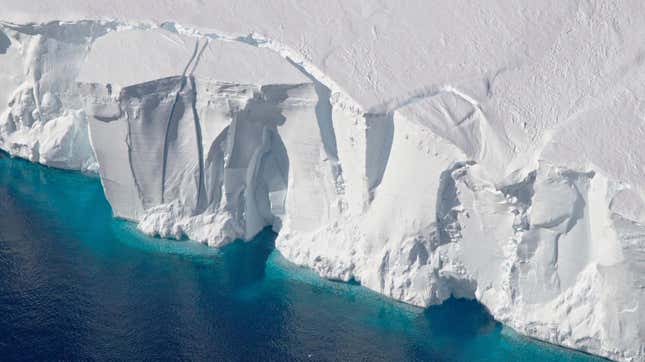
Look out world—the ice sheet is coming. New research says that the total collapse of a crucial ice sheet in Antarctica could mean that sea levels would rise an additional 30% more than scientists currently predict.
The study, published Friday in Science Advances, deals with how the melting ice on the West Antarctic ice sheet will impact the Earth’s crust below. Current predictions say that the ice sheet will increase sea level rise by 10.8 feet (3.3 meters) if it melts fully over the next 1,000 years, but taking the bedrock into effect, this study found, could add a full 3.3 feet (1 meter) to current predictions. What’s more, the models the researchers used show that sea level rise predictions from the ice sheet by the end of this century could actually be 20% higher because of this bedrock effect.
“Every published projection of sea level rise due to melting of the West Antarctic ice sheet that has been based on climate modeling, whether the projection extends to the end of this century or longer into the future, is going to have to be revised upward because of their work,” Jerry Mitrovica, a geophysicist at Harvard University and author on the paper, said in a press release. “Every single one.”
The rock that underlies much of the West Antarctic ice sheet’s sits below sea level, meaning it is especially sensitive to warm ocean currents. How that water could burrow under the ice is one of the biggest question marks as we consider what could happen to sea levels as the planet continues to warm.
“Future change in the West Antarctic ice sheet is the biggest uncertainty in predictions of sea-level rise,” Robert Larter, a marine geophysicist at the British Antarctic Survey who was not involved with the study, wrote in an email. “Other contributions to sea level change (ocean thermal expansion, melting of mountain glaciers and ice caps, and ice loss from Greenland) can all be estimated with less uncertainty. The difficulty in predicting future change in the WAIS is that most of its bed lies below sea level, and under a large part of the bed gets deeper as you go further into the ice sheet.”
Scientists think that warm ocean currents are making the ice sheet’s underwater bed increasingly unstable. This instability could create a feedback loop as the top part of the sheet starts to melt, creating what Larter called a “point of no return” for the ice sheet. “However, as in the history of modern science we have never been able to observe a marine ice sheet retreat, we don’t have good observational data to determine how strong the feedbacks are and how fast the retreat might proceed,” he continued.
One big factor in how this collapse could impact us is, surprisingly, the Earth’s crust beneath the ice sheets themselves. As the ice sheet melts and the weight of the ice decreases, the bedrock will spring up like a mattress after you get up out of bed. In the case of the West Antarctic ice sheet, because its base is below sea level, the crust rising up will take up more space in the ocean.
“This will reduce the amount of accommodation space for water, driving up further sea level rise on time scales of thousands of years,” Bethan Davies, a glacier researcher at the Royal Holloway University of London who was not involved in the study, wrote in an email.
It’s this relationship that the specific research narrows in on: just how much this bedrock—not the melting ice itself—could make sea levels rise. The bedrock beneath the ice sheet, the study says, is a type of low-viscosity mantle that will “rebound rapidly” as the ice melts. The study authors wrote that previous work had estimated this bedrock effect “is small and occurs slowly.” Their models, however, show that it can have a substantial contribution to how sea level is affected by this particular ice sheet melting down.In addressing how the Earth’s crust will react to melting ice, Davies said this particular study tackles a crucial piece of figuring out the overall impact from the ice sheet.
“One uncertainty in predicting the future is how the Earth’s lithosphere will react to glacier recession,” she wrote. “We continuously try to refine this aspect of glacier dynamics. By using a new model and applying it over a long time, [the study authors] are studying a hitherto understudied aspect of long-term glacier evolution.”
Larter speculated that the big increase the study found compared to previous sea-level rise estimates could simply mean that scientists from across disciplines are finally talking to each other.
“This result arises from integrated modeling of the ice sheets and the solid Earth, study areas that have traditionally been the separate domains of glaciologists and geologists,” he said. “Over the past couple of decades, scientists have increasingly realized that to solve many important environmental science questions, we need to work across disciplines, and a particular example of this is the realization that the characteristics and response of the solid Earth beneath ice sheets are very important to predicting how they will change.”
While scientists have built increasingly reliable models to study what could happen to glaciers and ice, this study shows how much more there is to learn about what we’re in for as the planet continues to warm and we enter uncharted territory. And that’s not really a great place to be.